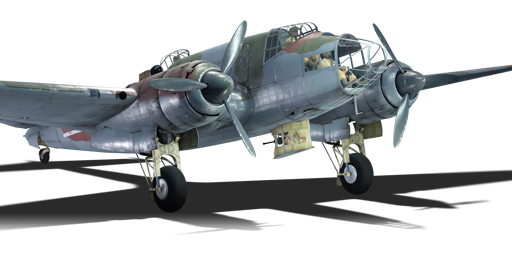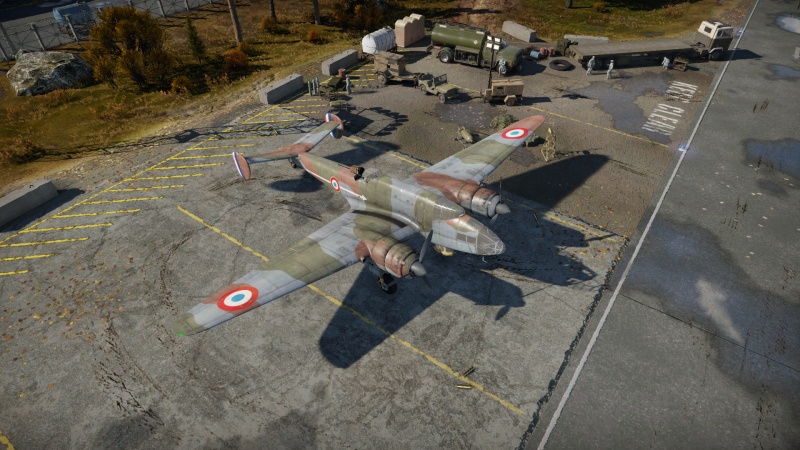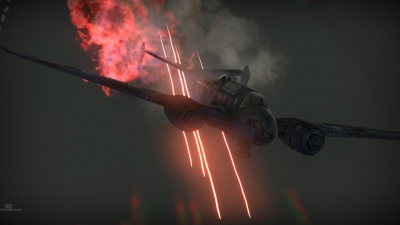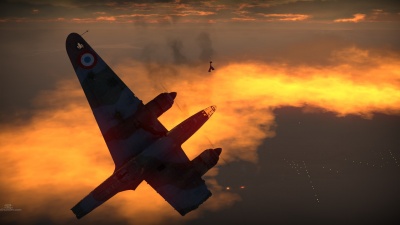Difference between revisions of "LeO 451 late"
Inceptor57 (talk | contribs) (adaption to new format) |
|||
| Line 1: | Line 1: | ||
{{Specs-Card | {{Specs-Card | ||
|code=leo_451_late | |code=leo_451_late | ||
| − | |images={{Specs-Card-Image|}} | + | |images={{Specs-Card-Image|GarageImage_LeO451Late.jpg}} |
| − | |||
| − | |||
| − | |||
| − | |||
| − | |||
}} | }} | ||
== Description == | == Description == | ||
| − | <!--''In the description, the first part | + | <!-- ''In the description, the first part should be about the history of and the creation and combat usage of the aircraft, as well as its key features. In the second part, tell the reader about the aircraft in the game. Insert a screenshot of the vehicle, so that if the novice player does not remember the vehicle by name, he will immediately understand what kind of vehicle the article is talking about.'' --> |
| − | |||
| − | |||
The '''{{Specs|name}}''' is a Rank {{Specs|rank}} French bomber {{Battle-rating}}. It was introduced in [[Update 1.79 "Project X"]]. | The '''{{Specs|name}}''' is a Rank {{Specs|rank}} French bomber {{Battle-rating}}. It was introduced in [[Update 1.79 "Project X"]]. | ||
| Line 18: | Line 11: | ||
=== Flight performance === | === Flight performance === | ||
{{Specs-Avia-Flight}} | {{Specs-Avia-Flight}} | ||
| − | <!--''Describe how the aircraft behaves in the air. | + | <!-- ''Describe how the aircraft behaves in the air. Speed, manoeuvrability, acceleration and allowable loads - these are the most important characteristics of the vehicle.'' --> |
{| class="wikitable" style="text-align:center" width="70%" | {| class="wikitable" style="text-align:center" width="70%" | ||
| Line 76: | Line 69: | ||
=== Survivability and armour === | === Survivability and armour === | ||
{{Specs-Avia-Armour}} | {{Specs-Avia-Armour}} | ||
| − | <!--''Examine the survivability of the aircraft. Note how vulnerable the structure is and how secure the pilot is, whether the fuel tanks are armoured. Describe the armour, if there is any, also mention the vulnerability of other critical aircraft systems.''--> | + | <!-- ''Examine the survivability of the aircraft. Note how vulnerable the structure is and how secure the pilot is, whether the fuel tanks are armoured, etc. Describe the armour, if there is any, and also mention the vulnerability of other critical aircraft systems.'' --> |
* 12 mm behind the pilot | * 12 mm behind the pilot | ||
| Line 91: | Line 84: | ||
=== Offensive armament === | === Offensive armament === | ||
{{Specs-Avia-Offensive}} | {{Specs-Avia-Offensive}} | ||
| − | <!--''Describe the offensive armament of the aircraft, if any. Describe how effective the cannons and machine guns are in a battle, and also what belts or drums are better to use. If there is no offensive weaponry, delete this subsection.''--> | + | <!-- ''Describe the offensive armament of the aircraft, if any. Describe how effective the cannons and machine guns are in a battle, and also what belts or drums are better to use. If there is no offensive weaponry, delete this subsection.'' --> |
{{main|MAC 1934 (7.5 mm)}} | {{main|MAC 1934 (7.5 mm)}} | ||
| Line 98: | Line 91: | ||
=== Suspended armament === | === Suspended armament === | ||
{{Specs-Avia-Suspended}} | {{Specs-Avia-Suspended}} | ||
| − | <!--''Describe the aircraft's suspended armament: additional cannons under the wings, bombs, rockets and torpedoes. This section is especially important for bombers and attackers. If there is no suspended weaponry remove this subsection.''--> | + | <!-- ''Describe the aircraft's suspended armament: additional cannons under the wings, bombs, rockets and torpedoes. This section is especially important for bombers and attackers. If there is no suspended weaponry remove this subsection.'' --> |
{{main|G.A.M.Mn 50 (50 kg)|№.1 (100 kg)|№.1 (200 kg)|№.2 (500 kg)}} | {{main|G.A.M.Mn 50 (50 kg)|№.1 (100 kg)|№.1 (200 kg)|№.2 (500 kg)}} | ||
| Line 110: | Line 103: | ||
=== Defensive armament === | === Defensive armament === | ||
{{Specs-Avia-Defensive}} | {{Specs-Avia-Defensive}} | ||
| − | <!--''Defensive armament with turret machine guns or cannons, crewed by gunners. Examine the number of gunners and what belts or drums are better to use. If defensive weaponry is not available remove this subsection.''--> | + | <!-- ''Defensive armament with turret machine guns or cannons, crewed by gunners. Examine the number of gunners and what belts or drums are better to use. If defensive weaponry is not available, remove this subsection.'' --> |
{{main|MAC 1934 (7.5 mm)|Hispano 404 (20 mm)}} | {{main|MAC 1934 (7.5 mm)|Hispano 404 (20 mm)}} | ||
| Line 119: | Line 112: | ||
== Usage in battles == | == Usage in battles == | ||
| − | <!--''Describe the tactics of playing in | + | <!-- ''Describe the tactics of playing in the aircraft, the features of using aircraft in a team and advice on tactics. Refrain from creating a "guide" - do not impose a single point of view, but instead, give the reader food for thought. Examine the most dangerous enemies and give recommendations on fighting them. If necessary, note the specifics of the game in different modes (AB, RB, SB).'' --> |
In Simulator Battles, the Leo 451 can be used as more than just a bomber. Due to the size of the aircraft, it is able to manoeuvre more like a heavy fighter allowing it to fight against other twin-engine aircraft or anything heavier. Unfortunately, the lack of proper offensive armament means that scoring hits will do little other than damage fuel and oil tank in most cases. In any kind of aerial combat, the dorsal gunner is one of the best options for scoring solid hits, especially when flying under other aircraft and firing upwards into them. Flying this close to get a shot comes with risks as flying in front of the enemies guns will also paint a target on your aircraft. For defending from fighters a good tactic is to gain some altitude so that when an enemy appears you can accelerate into a dive. A fast aircraft makes it much harder for fighters to close the distance giving the dorsal gunner and opportunity to do his job. While diving to make an aircraft fast can be a good thing, it is important to not go too fast as the wings are not invincible and will potentially rip off. Turning in this aircraft is relatively effective for a plane its size, though unfortunately, it does not handle like a sports car. Factors such as an empty bomb bay will increase its manoeuvrability to something closer to a heavy fighter. | In Simulator Battles, the Leo 451 can be used as more than just a bomber. Due to the size of the aircraft, it is able to manoeuvre more like a heavy fighter allowing it to fight against other twin-engine aircraft or anything heavier. Unfortunately, the lack of proper offensive armament means that scoring hits will do little other than damage fuel and oil tank in most cases. In any kind of aerial combat, the dorsal gunner is one of the best options for scoring solid hits, especially when flying under other aircraft and firing upwards into them. Flying this close to get a shot comes with risks as flying in front of the enemies guns will also paint a target on your aircraft. For defending from fighters a good tactic is to gain some altitude so that when an enemy appears you can accelerate into a dive. A fast aircraft makes it much harder for fighters to close the distance giving the dorsal gunner and opportunity to do his job. While diving to make an aircraft fast can be a good thing, it is important to not go too fast as the wings are not invincible and will potentially rip off. Turning in this aircraft is relatively effective for a plane its size, though unfortunately, it does not handle like a sports car. Factors such as an empty bomb bay will increase its manoeuvrability to something closer to a heavy fighter. | ||
| Line 142: | Line 135: | ||
| Not controllable || Controllable<br>Automatic pitch || Controllable || Not controllable || Combined || Controllable || Not controllable | | Not controllable || Controllable<br>Automatic pitch || Controllable || Not controllable || Combined || Controllable || Not controllable | ||
|- | |- | ||
| − | |||
| − | |||
| − | |||
| − | |||
| − | |||
| − | |||
| − | |||
| − | |||
| − | |||
| − | |||
| − | |||
| − | |||
| − | |||
| − | |||
| − | |||
| − | |||
| − | |||
| − | |||
| − | |||
| − | |||
| − | |||
| − | |||
| − | |||
| − | |||
| − | |||
| − | |||
| − | |||
| − | |||
| − | |||
| − | |||
| − | |||
| − | |||
| − | |||
| − | |||
| − | |||
| − | |||
| − | |||
|- | |- | ||
|} | |} | ||
=== Pros and cons === | === Pros and cons === | ||
| − | <!--'' | + | <!-- ''Summarise and briefly evaluate the vehicle in terms of its characteristics and combat effectiveness. Mark its pros and cons in the bulleted list. Try not to use more than 6 points for each of the characteristics. Avoid using categorical definitions such as "bad", "good" and the like - use substitutions with softer forms such as "inadequate" and "effective".'' --> |
'''Pros:''' | '''Pros:''' | ||
| Line 203: | Line 159: | ||
== History == | == History == | ||
| − | ''Describe the history of the creation and combat usage of the aircraft in more detail than in the introduction. If the historical reference turns out to be too | + | <!-- ''Describe the history of the creation and combat usage of the aircraft in more detail than in the introduction. If the historical reference turns out to be too long, take it to a separate article, taking a link to the article about the vehicle and adding a block "/History" (example: <nowiki>https://wiki.warthunder.com/(Vehicle-name)/History</nowiki>) and add a link to it here using the <code>main</code> template. Be sure to reference text and sources by using <code><nowiki><ref></ref></nowiki></code>, as well as adding them at the end of the article with <code><nowiki><references /></nowiki></code>. This section may also include the vehicle's dev blog entry (if applicable) and the in-game encyclopedia description (under <code><nowiki>=== In-game description ===</nowiki></code>, also if applicable).'' --> |
[[File:LeO_bomber_002.jpg|400px|thumb|right|A LeO 451 bomber's final moments after a fatal engine fire.]] | [[File:LeO_bomber_002.jpg|400px|thumb|right|A LeO 451 bomber's final moments after a fatal engine fire.]] | ||
Development of the LeO 451 began in the early 1930s, after the newly formed Armée de l'air issued the so called Plan I, intended to increase the number of modern military aircraft available to the French Air Force. As part of this plan, the young Air Force was keen on expanding and developing their strategic bombing branch. However, as the already available bombers, such as the Farman F.221, were considered unsuitable for the needs of the Air Force, a set of specifications was issued for the development of a brand new bomber. Among other aircraft manufacturers, Lioré et Olivier (which would be nationalized as part of SNCASE) also submitted their LeO 45 design. Being a long-time supplier to the French Air Force, Lioré et Olivier had a reputation of building reliable and effective bombers dating back to WW1. Thanks to this, the further development of the LeO 45 was approved. The first prototype (LeO 45-01), powered by a pair of Hispano-Suiza engines, took flight on 16 January 1937. Despite showing some minor issues, the LeO 45 prototype displayed excellent performance. A second prototype, equipped with a pair of Gnome-Rhone engines was also constructed and subsequently designated LeO 451-01. Testing of the 451 prototype began in October 1938. | Development of the LeO 451 began in the early 1930s, after the newly formed Armée de l'air issued the so called Plan I, intended to increase the number of modern military aircraft available to the French Air Force. As part of this plan, the young Air Force was keen on expanding and developing their strategic bombing branch. However, as the already available bombers, such as the Farman F.221, were considered unsuitable for the needs of the Air Force, a set of specifications was issued for the development of a brand new bomber. Among other aircraft manufacturers, Lioré et Olivier (which would be nationalized as part of SNCASE) also submitted their LeO 45 design. Being a long-time supplier to the French Air Force, Lioré et Olivier had a reputation of building reliable and effective bombers dating back to WW1. Thanks to this, the further development of the LeO 45 was approved. The first prototype (LeO 45-01), powered by a pair of Hispano-Suiza engines, took flight on 16 January 1937. Despite showing some minor issues, the LeO 45 prototype displayed excellent performance. A second prototype, equipped with a pair of Gnome-Rhone engines was also constructed and subsequently designated LeO 451-01. Testing of the 451 prototype began in October 1938. | ||
| Line 212: | Line 168: | ||
== Media == | == Media == | ||
| − | '' | + | <!-- ''Excellent additions to the article would be video guides, screenshots from the game, and photos.'' --> |
| − | + | ''Excellent additions to the article would be video guides, screenshots from the game, and photos.'' | |
| − | |||
| − | '' | ||
| + | == See also == | ||
| + | <!-- ''Links to the articles on the War Thunder Wiki that you think will be useful for the reader, for example:'' | ||
* ''reference to the series of the aircraft;'' | * ''reference to the series of the aircraft;'' | ||
| − | * ''links to approximate analogues of other nations and research trees.'' | + | * ''links to approximate analogues of other nations and research trees.'' --> |
| − | + | * [[LeO 451 early]] - Early variant of the LeO 451 | |
| − | == | + | == External links == |
| + | <!-- ''Paste links to sources and external resources, such as:'' | ||
| + | * ''topic on the official game forum;'' | ||
| + | * ''other literature.'' --> | ||
''Paste links to sources and external resources, such as:'' | ''Paste links to sources and external resources, such as:'' | ||
| − | |||
* ''topic on the official game forum;'' | * ''topic on the official game forum;'' | ||
| − | |||
* ''other literature.'' | * ''other literature.'' | ||
{{AirManufacturer LeO}} | {{AirManufacturer LeO}} | ||
{{France bombers}} | {{France bombers}} | ||
Revision as of 18:56, 25 December 2020
Contents
Description
The LeO 451 late is a Rank II French bomber with a battle rating of 3.0 (AB/RB/SB). It was introduced in Update 1.79 "Project X".
General info
Flight performance
| Characteristics | Max Speed (km/h at 6,250 m) |
Max altitude (meters) |
Turn time (seconds) |
Rate of climb (meters/second) |
Take-off run (meters) | |||
|---|---|---|---|---|---|---|---|---|
| AB | RB | AB | RB | AB | RB | |||
| Stock | 466 | 451 | 10500 | 31.3 | 32.2 | 3.1 | 3.1 | 550 |
| Upgraded | 517 | 490 | 28.8 | 30.0 | 9.6 | 5.8 | ||
Details
| Features | |||||
|---|---|---|---|---|---|
| Combat flaps | Take-off flaps | Landing flaps | Air brakes | Arrestor gear | |
| ✓ | ✓ | ✓ | X | X | |
| Limits | ||||||
|---|---|---|---|---|---|---|
| Wings (km/h) | Gear (km/h) | Flaps (km/h) | Max Static G | |||
| Combat | Take-off | Landing | + | - | ||
| 550 | 340 | 400 | 400 | 270 | ~7 | ~6 |
| Optimal velocities (km/h) | |||
|---|---|---|---|
| Ailerons | Rudder | Elevators | Radiator |
| < 315 | < 310 | < 350 | > 340 |
Survivability and armour
- 12 mm behind the pilot
- 12 mm behind the dorsal gunner
- Self-sealing fuel tanks (2 in each wing)
Modifications and economy
Armaments
Offensive armament
- 1 x 7.5 mm MAC 1934 machine gun, nose mounted (1500 rounds)
Suspended armament
The LeO 451 late can be outfitted with payload options of:
- 16 x 50 kg G.A.M.Mn 50 bombs (800 kg = total)
- 7 x 100 kg №.1 bombs (700 kg = total)
- 1 x 100 kg №.1 bombs + 6 x 200 kg №.1 bombs (1,300 kg = total)
- 2 x 500 kg №.2 bombs + 1 x 100 kg №.1 bombs + 4 x 200 kg №.1 bombs (1,900 kg = total)
Defensive armament
The LeO 451 late is defensively armed with:
- 1 x 20 mm Hispano 404 cannon, dorsal turret (120 rounds) + 2 x 7.5 mm MAC 1934 machine gun (750 RPG)
- 1 x 7.5 mm MAC 1934 machine gun, ventral turret (500 rounds)
Usage in battles
In Simulator Battles, the Leo 451 can be used as more than just a bomber. Due to the size of the aircraft, it is able to manoeuvre more like a heavy fighter allowing it to fight against other twin-engine aircraft or anything heavier. Unfortunately, the lack of proper offensive armament means that scoring hits will do little other than damage fuel and oil tank in most cases. In any kind of aerial combat, the dorsal gunner is one of the best options for scoring solid hits, especially when flying under other aircraft and firing upwards into them. Flying this close to get a shot comes with risks as flying in front of the enemies guns will also paint a target on your aircraft. For defending from fighters a good tactic is to gain some altitude so that when an enemy appears you can accelerate into a dive. A fast aircraft makes it much harder for fighters to close the distance giving the dorsal gunner and opportunity to do his job. While diving to make an aircraft fast can be a good thing, it is important to not go too fast as the wings are not invincible and will potentially rip off. Turning in this aircraft is relatively effective for a plane its size, though unfortunately, it does not handle like a sports car. Factors such as an empty bomb bay will increase its manoeuvrability to something closer to a heavy fighter.
When it comes to the ground attack role, the bombs are a gimmie, for destroying tanks and pillboxes, though, if lucky enough an entire armoured column may be destroyed. On the other hand, the nose gun can be used to attack lightly armoured ground targets such as trucks or anti-aircraft guns, while the 20 mm dorsal gun can be used to take out armoured cars.
Manual Engine Control
| MEC elements | ||||||
|---|---|---|---|---|---|---|
| Mixer | Pitch | Radiator | Supercharger | Turbocharger | ||
| Oil | Water | Type | ||||
| Not controllable | Controllable Automatic pitch |
Controllable | Not controllable | Combined | Controllable | Not controllable |
Pros and cons
Pros:
- Dorsal gunner has large ammunition pool
- Comes included with an offensive armament
- Very manoeuvrable after the payload has been released
- Accelerates very fast in a dive
- Abilities allow for it to multifunction as a bomber, heavy fighter and attacker
- Powerful dorsal turret
Cons:
- Dorsal gunners main gun runs out of ammunition before the coaxial 7.5 mm machine gun
- Offensive armament is insufficient for most engagements
- Prone to engine fires
- Aircraft does not excel in any particular role
- Many blind spots for gunners
History
Development of the LeO 451 began in the early 1930s, after the newly formed Armée de l'air issued the so called Plan I, intended to increase the number of modern military aircraft available to the French Air Force. As part of this plan, the young Air Force was keen on expanding and developing their strategic bombing branch. However, as the already available bombers, such as the Farman F.221, were considered unsuitable for the needs of the Air Force, a set of specifications was issued for the development of a brand new bomber. Among other aircraft manufacturers, Lioré et Olivier (which would be nationalized as part of SNCASE) also submitted their LeO 45 design. Being a long-time supplier to the French Air Force, Lioré et Olivier had a reputation of building reliable and effective bombers dating back to WW1. Thanks to this, the further development of the LeO 45 was approved. The first prototype (LeO 45-01), powered by a pair of Hispano-Suiza engines, took flight on 16 January 1937. Despite showing some minor issues, the LeO 45 prototype displayed excellent performance. A second prototype, equipped with a pair of Gnome-Rhone engines was also constructed and subsequently designated LeO 451-01. Testing of the 451 prototype began in October 1938.
However, due to various production issues associated with the Gnome-Rhone engine, production of the LeO 451 was delayed, beginning only in late 1938. Although the Armée de l'air only fielded a handful of operational LeO 451 bombers at the outbreak of WW2, their number would rise up prior to the Invasion of France in May 1940. During this chapter of WW2, the LeO 451 saw wide use against both advancing German forces on the east and Italian forces on the south. While the aircraft suffered great losses at the hands of Luftwaffe’s superior fighters and the Wehrmacht’s relentless anti-air guns, it fared a lot better on the southern front against Italian forces. Nonetheless, the LeO 451 did eventually retire in September 1957 as the final pre-war French aircraft to leave active duty.
- From Devblog
Media
Excellent additions to the article would be video guides, screenshots from the game, and photos.
See also
- LeO 451 early - Early variant of the LeO 451
External links
Paste links to sources and external resources, such as:
- topic on the official game forum;
- other literature.
| Lioré et Olivier (SNCASE) | |
|---|---|
| Bombers | LeO 451 early · LeO 451 late |
| France bombers | |
|---|---|
| Farman | F.222.2 · N.C.223.3 |
| Latécoère | Late 298D |
| Potez | Potez 633 |
| Liore et Olivier | LeO 451 early · LeO 451 late |
| Bloch | M.B.174A-3 · M.B.162 · M.B.175T |
| American | V-156-F · Martin 167-A3 · ▄A-35B · ▄SB2C-5 · B-26C · ▄PBY-5A Late · ▄PB4Y-2 |
| British | Lancaster MR.7 |







